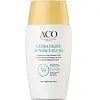What's inside
What's inside
 Key Ingredients
Key Ingredients

 Benefits
Benefits

 Concerns
Concerns

 Ingredients Side-by-side
Ingredients Side-by-side

Water
Skin ConditioningDiisopropyl Sebacate
EmollientDibutyl Adipate
EmollientDiethylamino Hydroxybenzoyl Hexyl Benzoate
UV FilterTris-Biphenyl Triazine
UV AbsorberEthylhexyl Salicylate
UV AbsorberPropanediol
SolventSilica
AbrasiveEthylhexyl Triazone
UV AbsorberBis-Ethylhexyloxyphenol Methoxyphenyl Triazine
Skin Conditioning1,2-Hexanediol
Skin ConditioningTocopheryl Acetate
AntioxidantPotassium Cetyl Phosphate
EmulsifyingCetyl Alcohol
EmollientBis-Ethylhexyl Hydroxydimethoxy Benzylmalonate
AntioxidantSarcosine
Skin ConditioningSodium Hyaluronate
HumectantDecyl Glucoside
CleansingVp/Eicosene Copolymer
Butylene Glycol
HumectantPentylene Glycol
Skin ConditioningXanthan Gum
EmulsifyingCarbomer
Emulsion StabilisingCitric Acid
BufferingDisodium Phosphate
BufferingSodium Benzoate
MaskingWater, Diisopropyl Sebacate, Dibutyl Adipate, Diethylamino Hydroxybenzoyl Hexyl Benzoate, Tris-Biphenyl Triazine, Ethylhexyl Salicylate, Propanediol, Silica, Ethylhexyl Triazone, Bis-Ethylhexyloxyphenol Methoxyphenyl Triazine, 1,2-Hexanediol, Tocopheryl Acetate, Potassium Cetyl Phosphate, Cetyl Alcohol, Bis-Ethylhexyl Hydroxydimethoxy Benzylmalonate, Sarcosine, Sodium Hyaluronate, Decyl Glucoside, Vp/Eicosene Copolymer, Butylene Glycol, Pentylene Glycol, Xanthan Gum, Carbomer, Citric Acid, Disodium Phosphate, Sodium Benzoate
Water
Skin ConditioningIsododecane
EmollientPropylene Glycol
HumectantButyl Methoxydibenzoylmethane
UV AbsorberTerephthalylidene Dicamphor Sulfonic Acid
UV AbsorberGlycerin
HumectantEthylhexyl Methoxycinnamate
UV AbsorberMethylene Bis-Benzotriazolyl Tetramethylbutylphenol
UV FilterDecyl Glucoside
CleansingXanthan Gum
EmulsifyingPhenylbenzimidazole Sulfonic Acid
UV AbsorberTriethanolamine
BufferingCaprylic/Capric Triglyceride
MaskingAmmonium Acryloyldimethyltaurate/Vp Copolymer
Tapioca Starch
Dicaprylyl Carbonate
EmollientEthylhexyl Salicylate
UV AbsorberDimethicone
EmollientCyclopentasiloxane
EmollientCetearyl Alcohol
EmollientCeteareth-20
CleansingCetearyl Olivate
Sorbitan Olivate
EmulsifyingPhenoxyethanol
PreservativeEthylhexylglycerin
Skin ConditioningGlyceryl Stearate
EmollientCarica Papaya Fruit Extract
Skin ConditioningGlyceryl Glucoside
HumectantNiacinamide
Smoothing3-O-Ethyl Ascorbic Acid
Skin ConditioningPolyester-7
Skin ConditioningNeopentyl Glycol Diheptanoate
EmollientSodium Polyacrylate
AbsorbentEthoxydiglycol
HumectantHyaluronic Acid
HumectantBiosaccharide Gum-4
Skin Conditioning1,2-Hexanediol
Skin ConditioningCapsicum Annuum Fruit Extract
AntimicrobialTocopheryl Acetate
AntioxidantSodium Gluconate
Skin ConditioningLaminaria Digitata Extract
Skin ProtectingCetyl-Pg Hydroxyethyl Palmitamide
Skin ConditioningCeramide EOP
Skin ConditioningCeramide Ng
Skin ConditioningCeramide NP
Skin ConditioningCeramide As
Skin ConditioningCeramide AP
Skin ConditioningPanthenol
Skin ConditioningBHT
AntioxidantWater, Isododecane, Propylene Glycol, Butyl Methoxydibenzoylmethane, Terephthalylidene Dicamphor Sulfonic Acid, Glycerin, Ethylhexyl Methoxycinnamate, Methylene Bis-Benzotriazolyl Tetramethylbutylphenol, Decyl Glucoside, Xanthan Gum, Phenylbenzimidazole Sulfonic Acid, Triethanolamine, Caprylic/Capric Triglyceride, Ammonium Acryloyldimethyltaurate/Vp Copolymer, Tapioca Starch, Dicaprylyl Carbonate, Ethylhexyl Salicylate, Dimethicone, Cyclopentasiloxane, Cetearyl Alcohol, Ceteareth-20, Cetearyl Olivate, Sorbitan Olivate, Phenoxyethanol, Ethylhexylglycerin, Glyceryl Stearate, Carica Papaya Fruit Extract, Glyceryl Glucoside, Niacinamide, 3-O-Ethyl Ascorbic Acid, Polyester-7, Neopentyl Glycol Diheptanoate, Sodium Polyacrylate, Ethoxydiglycol, Hyaluronic Acid, Biosaccharide Gum-4, 1,2-Hexanediol, Capsicum Annuum Fruit Extract, Tocopheryl Acetate, Sodium Gluconate, Laminaria Digitata Extract, Cetyl-Pg Hydroxyethyl Palmitamide, Ceramide EOP, Ceramide Ng, Ceramide NP, Ceramide As, Ceramide AP, Panthenol, BHT
 Reviews
Reviews

Ingredients Explained
These ingredients are found in both products.
Ingredients higher up in an ingredient list are typically present in a larger amount.
1,2-Hexanediol is a synthetic liquid and another multi-functional powerhouse.
It is a:
- Humectant, drawing moisture into the skin
- Emollient, helping to soften skin
- Solvent, dispersing and stabilizing formulas
- Preservative booster, enhancing the antimicrobial activity of other preservatives
Decyl Glucoside is a glucose-based surfactant and emulsion stabilizer. It is created by reacting glucose with the fatty acids from plants.
Surfactants help clean the skin by trapping oil, sebum, and dirt to be washed away. As an emulsion stabilizer, it stabilizes the ingredients in a product by preventing them from separating.
This ingredient is biodegradable and non-toxic. This ingredient is commonly found in baby shampoos.
Decyl Glucoside is sometimes used to stabilize the UV filter Tinosorb.
Learn more about Decyl GlucosideEthylhexyl Salicylate is an organic compound used to block UV rays. It primarily absorbs UVB rays but offers a small amount of UVA protection as well.
Commonly found in sunscreens, Ethylhexyl Salicylate is created from salicylic acid and 2-ethylhexanol. You might know salicylic acid as the effective acne fighter ingredient and BHA.
The ethylhexanol in this ingredient is a fatty alcohol and helps hydrate your skin, similar to oils. It is an emollient, which means it traps moisture into the skin.
According to manufacturers, Ethylhexyl Salicylate absorbs UV wavelength of 295-315 nm, with a peak absorption at 307-310 nm. UVA rays are linked to long term skin damage, such as hyperpigmentation. UVB rays emit more energy and are capable of damaging our DNA. UVB rays cause sunburn.
Learn more about Ethylhexyl SalicylateTocopheryl Acetate is AKA Vitamin E. It is an antioxidant and protects your skin from free radicals. Free radicals damage the skin by breaking down collagen.
One study found using Tocopheryl Acetate with Vitamin C decreased the number of sunburned cells.
Tocopheryl Acetate is commonly found in both skincare and dietary supplements.
Learn more about Tocopheryl AcetateWater. It's the most common cosmetic ingredient of all. You'll usually see it at the top of ingredient lists, meaning that it makes up the largest part of the product.
So why is it so popular? Water most often acts as a solvent - this means that it helps dissolve other ingredients into the formulation.
You'll also recognize water as that liquid we all need to stay alive. If you see this, drink a glass of water. Stay hydrated!
Learn more about WaterXanthan gum is used as a stabilizer and thickener within cosmetic products. It helps give products a sticky, thick feeling - preventing them from being too runny.
On the technical side of things, xanthan gum is a polysaccharide - a combination consisting of multiple sugar molecules bonded together.
Xanthan gum is a pretty common and great ingredient. It is a natural, non-toxic, non-irritating ingredient that is also commonly used in food products.
Learn more about Xanthan Gum